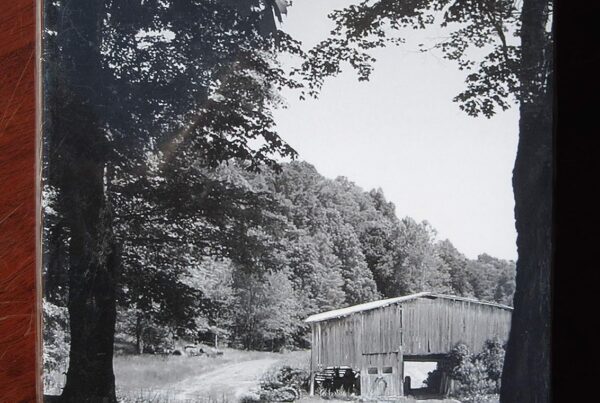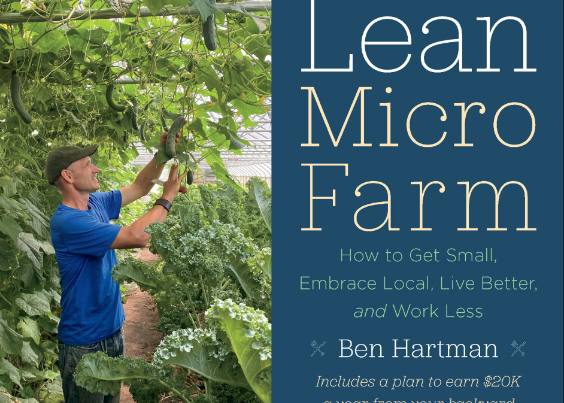
The Berry Grower: Small Scale Organic Fruit Production in the 21st Century, Blake Cothron, New Society Publishers, paperback, 300 pages, May 2022, black and white and color photos, $39.99
Here you can read about growing berries and other small fruits on a backyard or small commercial scale, and see how they can work for you. You can learn up-to-the-minute information relevant to organic farming, urban farming and the local foods movement. You can learn which modern cultivars hold the most hope for your location.
This is not a glossy coffee-table book. Nor is it written for fulltime fruit growers. Blake wrote this book to encourage a move to more localized and resilient organic food production on a global scale, garden by garden. He wants to spread practical, effective knowledge and training. Blake speaks from 20 years’ experience growing small fruit, including the past ten years operating a successful commercial organic plant nursery.
Blake quotes Bill Mollison, suggesting that if 10% of us switch from consumption to production, there will be enough food for everyone. Small fruits are a good place to start, because they bring faster returns (6-12 months) compared to tree fruits, and the demand is almost infinite. It’s easier to satisfy the demand for fresh vegetables, than for fresh fruit! Small fruits do not require a large area, and won’t shade out your vegetables. Once your fruit crops need most of your attention, you can cut back on vegetable crops for market. Fruit can provide more income for the time invested, if not for the space. Size your operation so you and your household can do 90-100% of the work yourselves, as paying others cuts into what could be your profits.
Small fruit crops deserve more attention than they’ve had from growers or writers in recent years. This book addresses the shortage of up-to-date information, and the reality of climate chaos. By growing a diversity of crops, your risks are spread and reduced. Note which crops do best and grow more of those! Blake reports that in his Kentucky garden, all the blackberries, red and black raspberries, strawberries, aronia, figs, gooseberries, juneberries, blueberries, passionfruit, and honeyberries survived a very difficult winter and late spring frosts. Be prepared for winter low temperatures some years a full zone colder than previously, and also a full zone warmer other years. Or, if you are really unlucky, a yo-yo winter that can zap the blooms of early cultivars. Blake’s list of survivors above makes a good starting point of resilient fruit crops.
The Basics
The first section covers the planning and preparation: finding the plants you want, getting good tools, prepping the beds, then planting and maintaining the areas. Choose a site with full sun, good drainage of air and water, a low enough water table so that your crops will not get flooded, protection from strong winds, and ideally land with a gradual slope. Be alert to the micro-climates on your land.
Choose the species you’d most like to grow, of those that will thrive in your area. Be sure the fruit will ripen and you can prevent other creatures who might eat the fruit. Be sure there is an unsaturated demand for that particular fruit locally. Gooseberries have loyal fans, but not millions of them. Ask neighbors, grocery stores, commercial growers, your local Extension service and university ag department. At the same time, find out what publications, courses or funding are available. Don’t flood the market with more of the same, if you could focus on something else that many people want. Be realistic about likely yields. New growers and those growing heirlooms should expect half the published yield figures. Look at your costs.
Look at your climate, and pests and diseases you’ll likely contend with. Understand winter-hardiness zones for what they are, and look at all the factors other than coldest winter temperatures. Zone 6 in Washington State is like a highland desert; zone 6 in Kentucky is moist, humid and verdant. Notice your weather and signs of imminent change. Blake reports that he can hear distant train whistles not long before rain starts.
Get soil tests and add needed amendments. Prepare your beds ahead of time. Blake recommends using silage tarps for 60-90 days before planting (less in hot weather). Consider solarizing with clear plastic to cook any disease pathogens, nematodes and weed seeds in the top few inches. Just 6-7 days is enough when hot and sunny.
Choose cultivars that are productive, reliable, tolerant of the range of your weather, as well as well-flavored. If your plant only produces one superbly flavored fruit in good-enough condition to sell, that’s going to be so disappointing! There’s a useful summary at the end of the chapter, to make sure you cover all the bases before parting with your money.
This book guides you carefully through all the steps to get the plants established. Weed management and irrigation follow, and mulch. There are good tips on making beds (turning the soil and no-till, using tarps for 30-90 days, clear plastic for 7 days, and landscape fabric for long-term cover), and a thorough explanation of Integrated Pest Management. Learn about today’s bugs, and modern tools and methods. There is a one-page checklist of factors to consider when pests take over.
Next is an up-to-date chapter on buying plants. Or, sometimes, buying plant material (cuttings or divisions). There are warnings about accepting gifts from neighbors (pests, diseases, varieties that don’t grow that well). Just in case anyone is still unsure: hybrids are the result of breeding work that crosses open-pollinated varieties. You may have heard of hybrid vigor (the name we gave our first Prius!). Hybrids can bring good qualities from both sides of their family, providing productive, vigorous crops. They are not GMOs. There are no small fruit GMOs, except for a couple of research tomatoes and peppers, that are not sold on the open market. See the GM Crops List 2021, from ISAAA. Remember, if a nursery (such as Blake’s Peaceful Heritage Nursery) is Organic, it does not use or sell GMO’s. Also, be realistic: you can buy a non-Organic plant and by growing it in Organic soil, with Organic amendments, you can develop that little twig into a healthy shrub.
Learn how to handle cuttings, how to heel-in plants temporarily, and then how to plant (add nothing to the hole). Consider some useful tools. I wonder why I never bought a tapener, or a berry rake? They do look helpful.
The Crops
The second section starts with in-depth profiles of blackberries, blueberries, raspberries (black and red), strawberries, juneberries, muscadine grapes, gooseberries, currants, figs and – surprise – tomatoes.
There are descriptions of recommended cultivars, and Blake’s very useful Urban Market Farming Rating and Rural Market Farming Rating, comparing different fruits. Blackberries only get 2/5 for the Urban Farming Rating, but 4/5 for a Rural Farming Rating (the difference here is the income you might need for the area). In a home garden, you can use large tomato cages to support the canes. Blueberries are widely popular, and productive once established. The one-page Blueberry Soil Prescription by Lee Reich sums up what is importantly needed to succeed. Raspberries are Blake’s top choice, 5/5, for both urban and rural fruit plantings. Easy, popular, productive only 6-12 months after planting. I favor the fall fruiting types, particularly Caroline, because the canes bear fruit the same year they grow, so after fruiting you can mow the beds, and weed and make a fresh start each year.
Strawberries can be cultivated under either the annual production system or the matted row system. The options include fall-planted annual production, used in the south (zone 7a and milder). Annual production from spring starts involves pinching off the flowers in the first year, maintaining the plants for over a year before getting any harvests. If you can establish plants in the fall in your climate, you can get production the following spring and then choose between renovating the beds for a second production year, or terminating them. 4/5 in every situation.
Juneberries (shadbush, saskatoons, serviceberries), if you get a good cultivar, are like small blueberries with little almond-flavored seeds. Mediocre varieties are small, bland and watery, and prone to diseases. There are two main species of Juneberries: for Northern areas, Amelanchier alnifolia (Saskatoons), and the tree-form grown on the East coast (Amelanchier canadiensis) and a hybrid x grandiflora (serviceberry) with better disease resistance. The Alberta Government has published The Saskatoon Berry Production Manual.
Muscadine grapes (Vitis rotundifolia) are less well known north of Kentucky (zone 7). They are a native plant, considered by the author to be the best all-round organic market growing grape. (Also see the mention of the more cold-hardy Munson grapes in his Maybe section later). Muscadines are large, plump, sweet, aromatic and chewy. They have seeds and thick skins. They are extremely resistant to diseases and bugs, and they thrive in humidity! Fruiting starts in year 3, and increases to about 50-80 lbs (23-36kg) per plant. The large vines need a strong trellis, 12-20ft (3.7-6.1m) space each, and rigorous pruning. If planting female cultivars, you must include some self-fertile ones for pollination. The book suggests some good ones.
Mulberries have a big future. The trees are cold-hardy and late-blooming, so late frosts do not wipe out your harvest. Be sure to buy regionally-adapted species and cultivars. The more popular species include red mulberries (native in the Eastern US), white mulberries native to Asia and hardy to zones 4b-6, with berries that can be white, lavender, purple or black, and the black mulberry tree (native to Europe/Asia) which is hardy to zone 7. If you seek genuine Morus nigra, be careful to not get sold a black-fruiting Morus alba. Then there is the Himalayan Mulberry, Morus macroura, which seems hardy to zone 7, maybe 6. Mulberries are one of the easiest tree fruits to grow organically, but do note that trees are either male or female. Named cultivars are always female, but seedlings naturally can be either. Don’t plant the males unless you want to test your pollen allergies. Consider pruning your trees annually to a bush form, for easier harvesting, unless you want a large landscape tree. Illinois Everbearing is the deservedly most famous cultivar, suited to zones 4-9. Remember to prune, or the branches may break off. Mulberries have a low Urban Market Farming Rating, because the trees could shade other crops. and the roots could compete too much for nutrients. The Rural Market Farming rating is 5/5.
Gooseberries are only worthwhile in regions with a market for these northern European berries. Black, red and white currants can likewise do well in some locations and be wasted in others.
Figs do well when grown organically, although cold climates will limit their size and yield. Blake has them in a hoophouse. Consider an in-ground Walipini greenhouse. Be warned that fig latex is phytotoxic (can burn your skin, while also being an effective treatment for skin warts) — take care when harvesting. In humid regions, grow rust-resistant cultivars such as Celeste, Brown Turkey, Magnolia and the LSU cultivars. The book includes information about 17 cold-hardy figs (zones 5-7), 6 warm climate cultivars (zones 8-10) and 9 for hot, humid climates (zones 8-10). I learned a lot about figs from this book (I’ve never grown them). Ratings of 4/5 for Urban Market Farms, 5/5 for Rural ones.
Next are tomatoes, a crop I did not expect in a fruit book. Yes, of course they are a fruit. Here is solid information about growing tomatoes for market. Plant regionally-adapted cultivars, look for production, consistency, resiliency as well as flavor. Ignore heirlooms, go for the “heirloom-like” hybrids, which have greater vigor, reliability, disease-resistance, and yields, with attractive appearance. (Blake confesses to ignoring this advice early on, and regretting it later.) Marnero looks and tastes just like Cherokee Purple, but is very productive. Balance 10-25% of fancy types with plenty of hybrid red slicers. Here are tips on growing strong transplants, choosing a trellising system and keeping your eyes on yields and sales. Consider also selling plants, value-added products, and seeds. As a “casual” sideline, the author earned over $900 in sales of organic tomato seeds one year. 5/5 Ratings in urban and rural locations.
The Others to Consider
These main profiles are followed by shorter profiles of other fruits that you could consider growing: aronia, autumn olive, goumi, bush and Nanking cherries, kiwiberry (hardy kiwis), cactus fruits, cornelian cherry, hardy passionfruit, elderberry, feijoa, goji, various hybrid cane berries, rosehips, seaberry (sea buckthorn), Munson grapes (free cuttings from Grayson College for growers and researchers), che, and honeyberry. A few of these I had never heard of. Honeyberries (haskeps) ripen about two weeks before strawberries.
Harvesting, Marketing and the Future
Next follow chapters covering harvest, postharvest and marketing, and the future of small fruit growing. Blake has noticed that if you harvest your blackberries early every morning, you will avoid the beetles and birds which arrive at midday. Get there first and get more fruit, and make the patch unattractive to the pests! Harvest with both hands, always! Use buckets that strap to your body, or crates on carts that you pull down the row. Identify ways to reduce or eliminate unnecessary movements, including not handling fruit more times than you must. Pick straight into marketable containers.
Interviews
The book includes two interviews with successful small fruit growers, focusing on education, outreach, direct marketing, diversity of crops, and a creative, resilient, ambitious, hardworking, patient, smart mindset. These are detailed interviews of 4-6 pages.
Climate Change and Fruit Growing
Commercial fruit requires (mostly) perennial plants that bloom when triggered by the internal timer of the plant. You can’t delay fruit bloom the way you can delay broccoli heading by planting later. Growers may need to switch to different cultivars, or different fruits more suited to newer and potential-future conditions. The book suggests how growers can contribute to breeding efforts and selection of better cultivars: later blooming or lower chill hour requirements, hardier buds and blooms, more heat and drought tolerance, more resistance to diseases and pests, reduced days to maturity, better resistance to heavy or repeated rains, and last but not least, increased nutritional value. Blake spells out a 7-step process for growers selecting their own cultivars, to bring resiliency back to our farms and to future generations.
Get this book and apply Blake’s experience and wisdom to your fruit plantings, diet or market!






